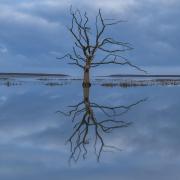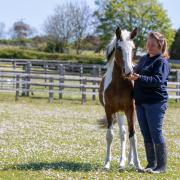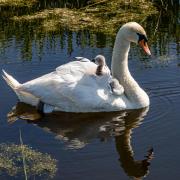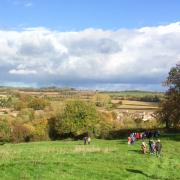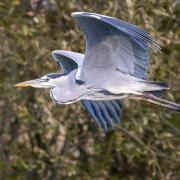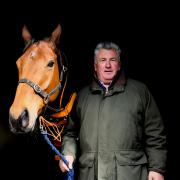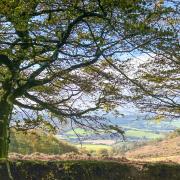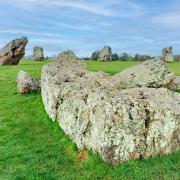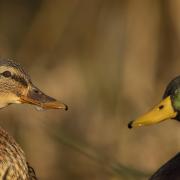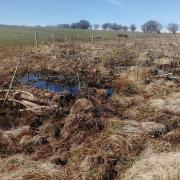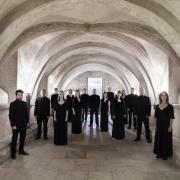A botanical artist tells Tim Saunders how she worries about the future of the natural world.

When Patricia Regnart from South Petherton paints a picture of a wildflower, she is concerned that she may never see this species again. “I have seen so much important flora and flora disappear over the years,” reveals Patricia, who has been a member of the Society of Botanical Artists since 1991 and exhibits annually in London and bi-annually at the Palmengarten Gallery, Frankfurt.
“In my childhood we took wildflowers for granted,” recalls Patricia as she admires her garden with its apple trees and pond full of waterlilies.
“I’d go for a walk at night and the ox-eye daisies were so white that they would glow in the moonlight and guide me home. Now I have to travel far and wide to find the most ordinary flowers in spring, such as white or blue violets, wood anemones, or vetches of various kinds, which were a common sight even 20 years ago.”
Distraught about the loss of habitats, she has witnessed the destruction of wildflower meadows from pesticides and herbicides. “Pesticides can contaminate soil, water, turf and other vegetation,” Patricia explains, adding that contamination lasts for years. “In addition to killing insects or weeds, these chemicals can be toxic to a host of other organisms including birds, fish, beneficial insects, and plants.” She holds the actions of man accountable for this destruction, which includes the continued loss of verges and hedgerows.

The State of Nature report identifies that over the past 50 years a significant number of species, including birds, butterflies and mammals, have declined. Hedgehogs have suffered greatly. The report, compiled by 70 wildlife groups across the UK, predicts that Britain will fail to meet most conservation targets for 2020. It blames pollution of rivers and streams, intensive farming and development for destroying wildlife habitat.
Through her paintings Patricia hopes to make the public aware of what is being lost and perhaps prevent more of our once common flowers and plants from vanishing forever. All is not doom and gloom though because on rare occasions Patricia does discover a plant that she has not come across before.
“I love the challenge of finding something new and unexpected that demands all observational and painting skills available.”
In search of subjects Patricia has travelled with her husband to France, Italy, Spain and New Zealand. This year she plans to revisit the West of Ireland where she will paint for much of the summer.
Despite living much of her life in Britain, there’s still a hint of that Irish twang. Born in Leicestershire, the family moved to Ireland when she was eight; her father having bought a farm in County Cork.
There, wonderful landscapes and colours had a lasting effect and Patricia drew and painted from a young age. “No sprays or herbicides were used in those days and the proliferation of plants and grasses was unforgettable,” says Patricia.
A keen gardener, she grows many vegetables.
“My garden is a source of endless interest, back-breaking work and a determination to produce as many vegetables as possible. Some people are surprised to see leeks, parsnips and herbacious plants growing side by side, intermingled with garlic and lettuce. It just depends where there is a space and whether the rotation is correct at the time. Some plants, such as hellebores, which love the soil here, find their way into my paintings.”
Among many memories, one, of painting at the horse fair at Cahir, stands out. Eventually she went on to study drawing and commercial art at the National College of Art, Dublin; going on to study painting and printmaking at the City & Guilds School of Art, London. She won a travel award for study in Florence. Later she became tutor of botanical drawing at the City & Guilds Art School.
“We’d have away days to Kew Gardens and to the Natural History Museum,” she recalls.
French artist Jacques le Moyne de Morgues (1533 to 1588), a member of Jean Ribault’s expedition to the New World, is an inspiration for Patricia. So too are the Bauer brothers, Ferdinand (1760 to 1826) and Franz (1758 to 1840) and the ‘masters of printmaking’ Rembrandt and Albrecht Durer.
In 2002 Patricia moved from Beer, Devon, to be nearer to her mother in Somerset. Her home is large enough to house her precious printing press. It is this press that she has used to create numerous prints. She was commissioned by Peter Bell, of Fine Arts, Burford, Oxfordshire, to create topographical etchings of the surrounding countryside in colour. She has also made many drypoints of landscape in County Clare, Ireland, Wales and cityscapes in London and Venice.
Patricia has had work with the Bridgeman Art Library and her print of Great Barrington is in the Government Art Collection. As a member of Creative Coverage she participates in exhibitions, most recently a group show at Ilminster Art Centre. Every now and then her work appears at auction.
Art is a tough industry as Patricia has found. “In the ‘90s there was a general economic downturn. Many people lost their jobs and businesses went to the wall. Among the fatalities were many art galleries. Six of these I had work with and at the same time my teaching came to an end. A serious decision had to be made and with difficulty I moved house to Herefordshire from West Oxon, which I have always regretted. However, it set me on the path to making five house moves in eight years as the housing market recovered. And so I learned a great deal about property development and DIY.
Unfortunately, some bad experiences with builders taught me to be self-reliant. I learned how to use a drill, screw down floorboards, point walls, put up chain-link fencing - and I am an excellent tiler!”




